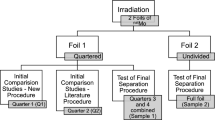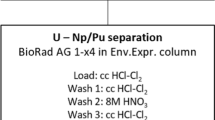Summary
Different analytical separation procedures were investigated by radioactive tracer techniques.
By liquid-liquid extraction with isoamylacetate it was found possible to eliminate traces of chromium from a great excess of iron. The iron thus purified was tested for residual Cr by thermal neutron irradiation. A corresponding extraction technique, using cuproïne in isoamylalcohol as extractant, was used for the separation of traces of copper from irradiated zinc.
The quantitative extraction of zinc with methyldioctylamine in xylol and the quantitative character of the Zn[Hg(SCN)4] precipitation were furthermore proved.
The separation of nickel and cobalt by dimethylglyoxime precipitation was investigated with65Ni and60Co tracers. About 0.6% cobalt was coprecipitated.
Coprecipitation of sodium with potassium dipicrylaminate and with potassium tetraphenylborate was found to be about 0.5%. As this decontamination was sufficient to permit selectiveβ-counting of42K in presence of24Na, no double precipitation purification step was attempted.
Zusammenfassung
Verschiedene analytische Trennungsverfahren wurden mit Hilfe radiometrischer Indikatormethoden überprüft.
Durch Flüssig-flüssig-Extraktion mit Isoamylacetat lassen sich Chromspuren aus großen Eisenüberschüssen entfernen. Das so gereinigte Eisen wurde durch Bestrahlung mit thermischen Neutronen auf Chromreste geprüft. Ein analoges Extraktionsverfahren mit isoamylalkoholischer Cuproinlösung wurde zur Abtrennung von Kupferspuren aus bestrahltem Zink verwendet. Weiters wurden die quantitative Extraktion von Zink mit Methyldioctylamin in Xylol und die Vollständigkeit der Fällung von Zink-Thiocyanatomercuriat überprüft. Die Trennung von Nickel und Kobalt mittels Dimethylglyoxim wurde mit Spuren65Ni und60Co untersucht. Ungefähr 0,6% Kobalt wurden mitgefällt. Die mit Kaliumdipikrylaminat und Kaliumtetraphenylborat mitgefällte Natriummenge beträgt etwa 0,5%. Da diese Reinigung zur selektiven Messung derβ-Aktivität des42K in Gegenwart von24Na ausreicht, wurde keine weitere Reinigung durch wiederholte Fällung versucht.
Résumé
Plusieurs méthodes de séparations analytiques furent contrôlées à l'aide de traceurs radioactifs. Il s'avéra possible d'éliminer des traces de chrome d'un excès de fer en employant une technique d'extraction liquide-liquide à base d'acétate d'isoamyle. Le degré de purification du fer fut contrôlé par irradiation dans un flux de neutrons thermiques.
Le 2-2′ dichinolyle fut employé pour l'extraction sélective de traces de cuivre d'un échantillon de zinc irradié. Il fut ensuite prouvé que le zinc peut être isolé quantitativement par extraction au méthyle-dioctylamine ou en le précipitant sous la forme de Zn[Hg(SCN)4].
La séparation nickel-kobalt à l'aide du diméthyleglyoxime fut contrôlée à l'aide de65Ni et de60Co. Environ 0,5% du cobalt présent fut coprécipité dans les conditions expérimentales données. Enfin, la coprécipitation du sodium avec le dipicrylaminate ou le tetraphénylborate de potasse fut déterminée; en moyenne elle fut de l'ordre de 0,5%.
Similar content being viewed by others
Literature
J. Pijck, De radiometrische bepaling van sporenelementen in biologisch materiaal. Doctoral Thesis Univ. of Ghent, Belgium. 1959;J. Pijck, J. Gillis, andJ. Hoste, La détermination du Cu, Cr, Zn et Co dans le sérum par radioactivation. J. A. R. I., in press.
NBS circular 499, Nuclear Data (January 1950).
NBS circular 499, Supplement 1 (July 1950).
Harwell, Catalogue of Isotopes No. 4 (1957).
TID-5300, Nuclear Level Schemes (1955).
V. S. Dzelepov andL. K. Peker, AECL-457 (1957); Decay Schemes of Radioactive Isotopes.
J. E. Wells andD. P. Hunter, Analyst73, 671 (1948).
A. R. Denaro andV. J. Occleshaw, Analyt. Chim. Acta13, 239 (1955).
J. Hoste, Verh. Kon. VI. Acad.39, 11 (1952).
J. Hoste, A. Heiremans, andJ. Gillis, Mikrochim. Acta [Wien]36/37, 349 (1951).
G. H. Morrison andH. Freiser, Solvent Extraction in Analytical Chemistry. New York: Wiley. 1957.
Author information
Authors and Affiliations
Additional information
Dedicated to Prof. Dr. Ing.Fritz Feigl on occasion of his 70th birthday.
Research Fellow I. I. K. W. (Belgium).
Rights and permissions
About this article
Cite this article
Pijck, J., Hoste, J. & Gillis, J. Radiometric control of analytical separation procedures. Mikrochim Acta 50, 76–86 (1962). https://doi.org/10.1007/BF01220325
Received:
Issue Date:
DOI: https://doi.org/10.1007/BF01220325




